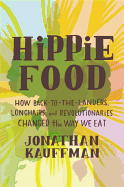
Where did all this kale come from? Food writer Jonathan Kauffman knows all too well--tofu and lentils defined his 1970s Indiana childhood dinners. Hippie Food is Kaufmann's affectionate history of the U.S. food revolution and how it infiltrated the mainstream.
The cultural shifts of the late 1960s reflected a sense of broken trust on the part of the boomer generation, who had been raised in post-World War II prosperity and then been shocked out of their complacency by the civil rights movement and the Vietnam War. Distrust of institutions and mainstream culture festered, and what were once radical fringe ideas about diet spread in a rebellion against "plastic" mainstream food. Kaufmann tells the interconnecting stories of influential groups, farmers, performance artists, food writers and restaurants. Occasional inset boxes define ingredients such as alfalfa sprouts, granola and carob, "the ersatz chocolate with the waxy, insipid taste that traumatized so many children in the 1970s (ahem)." He breaks his story into three eras: the "prehistory" reaching back into the 19th century; the "revolutionary era" 1968-1974; and post-Vietnam War, when "revolution gave way to lifestyle changes." Macrobiotics was one of the first of many movements to promote the idea that diet could create flawless health and a perfect society. Adherents founded food-buying clubs, held meetings and published books and pamphlets. They also chain-smoked, and a few died of malnutrition. Kaufmann explains how the alternative farm-to-table economy failed in many ways but also persists today. "It may have become harder to be a food revolutionary, but it has become a hell of a lot easier to shop like one." --Sara Catterall

